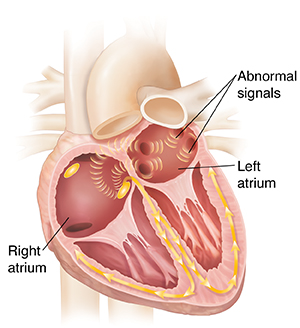Understanding Atrial Fibrillation (AFib)
Atrial fibrillation (AFib) is the most common type of arrhythmia. An arrhythmia is any problem with the speed or pattern of the heartbeat. AFib causes fast, chaotic electrical signals in the atria. This makes it hard for the heart to work as it should. It affects how much blood your heart can pump out to the body.
AFib may occur once in a while and go away on its own. This is called paroxysmal. Or it may continue for longer periods. This is called persistent.
AFib can lead to serious problems, such as stroke. Your healthcare provider will need to watch and manage your condition.

What happens during atrial fibrillation?
The heart has an electrical system. This sends signals to control the heartbeat. As the signals move through the heart, they tell the heart’s upper chambers (atria) and lower chambers (ventricles) when to squeeze (contract) and relax. This lets blood move through the heart and out to the body and lungs.
With AFib, the atria get abnormal signals. This causes them to contract in a fast and irregular way. They are out of sync with the ventricles. The atria have a harder time moving blood into the ventricles. Blood may then pool in the atria. This increases the risk for blood clots and stroke. The ventricles may contract too quickly and irregularly. They may not pump blood to the body and lungs as well as they should. This can weaken the heart muscle over time. This can lead to heart failure. Heart failure means the heart muscle can’t pump blood well.
What causes atrial fibrillation?
AFib is more common in older adults. It has many possible causes:
-
Older age
-
Coronary artery disease
-
Heart valve disease
-
Heart attack
-
Heart surgery
-
High blood pressure
-
Thyroid disease
-
Diabetes
-
Lung disease
-
Sleep apnea
-
Heavy alcohol use
In some cases of AFib, healthcare providers don't know the cause.
What are the symptoms of atrial fibrillation?
AFib may not cause symptoms. If symptoms do occur, they may include:
How is atrial fibrillation treated?
Treatments for AFib can include any of the below.
-
Medicines. You may be prescribed:
-
Heart rate medicines to help slow down the heartbeat
-
Heart rhythm medicines to help the heart beat more regularly
-
Blood thinners or anti-clotting medicines to help reduce the risk for blood clots and stroke
-
Left atrial appendage closure. Your healthcare provider may advise this to prevent stroke. You may need it if you are at high risk for stroke but have problems taking blood-thinner (anticoagulant) medicines. This is a procedure done through a catheter in the groin. A device is placed in the part of the heart. This is where most clots form. This area is called the left atrial appendage (LAA). It's a pouch-like structure in the muscle wall of the left atrium. The device closes off the LAA. This prevents clots moving from the heart to the brain and causing a stroke.
-
Electrical cardioversion. Your healthcare provider uses special pads or paddles to send 1 or more brief electrical shocks to the heart. This can help reset the heartbeat to normal.
-
Ablation. Long, thin tubes (catheters) are threaded through a blood vessel to the heart. In the heart, the catheters send out hot or cold energy to the places that cause the abnormal signals. This destroys the problem tissue or cells. This improves the chances that your heart will stay in normal rhythm without using medicines. If your heart rate and rhythm can’t be controlled, you may need an AV node ablation and a pacemaker. These will help control the heart rate and regularity of the heartbeat.
-
Surgery. Your healthcare provider may use a method to create scar tissue in the parts of the heart causing the abnormal signals. The scar tissue disrupts the abnormal signals. This may stop AFib from occurring. Most often, the left atrial appendage is closed off as well.
-
Hybrid surgical-catheter ablation for AFib. This is used for people with AFib that continues or is hard to treat. It combines surgery with a catheter ablation. First, the surgeon makes small cuts (incisions) between the ribs in the chest or in the abdomen near the sternum. The surgeon puts a scope through the incisions. This is done to get to the backside and other areas of the heart. Energy is sent to the surface of the atria. This disrupts the abnormal electrical signals. Then a catheter is put into a vein in the groin. The catheter is guided into the heart. Using the catheter, radiofrequency ablation is done. This destroys any other tissue inside the heart that is causing the AFib. It's also done to assess the success of the surgery. This hybrid treatment may work better to block the abnormal electrical signals. It may be a more permanent fix for persistent AFib.
What are possible complications of atrial fibrillation?
Complications can include:
-
Blood clots
-
Stroke
-
Dementia
-
Heart failure
When should I call my healthcare provider?
Call your healthcare provider right away if you have any of these:
Online Medical Reviewer:
Anne Clayton APRN
Online Medical Reviewer:
Stacey Wojcik MBA BSN RN
Online Medical Reviewer:
Steven Kang MD
Date Last Reviewed:
1/1/2022
© 2000-2024 The StayWell Company, LLC. All rights reserved. This information is not intended as a substitute for professional medical care. Always follow your healthcare professional's instructions.